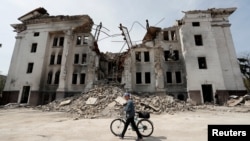In a May 10 interview with Alternativna TV (ATV), a Republic of Srpska-based private media outlet, Kremlin spokesman Dmitry Peskov claimed Russia was unable to defeat Ukraine after more than a year of war because of Moscow’s humanitarian concern for the preservation of Ukrainian cities and human lives.
ATV is linked to the family of Milorad Dodik, president of Bosnia’s Serb-run part of three-member panel making up the Bosnia and Herzegovina Presidency. Dodik controls the outlet and uses it for political purposes. Both Dodik and ATV have been under United States sanctions since January 2022, for corruption and the destabilization of the Western Balkans.
Peskov told ATV that Russia is militarily superior to Ukraine, but that the Russians are “so slow” in winning because:
"We are not waging a war. It is a totally different thing to wage a war; it is a total destruction of infrastructure; it is a total destruction of cities. We are not doing that. We seek to preserve the infrastructure; we seek to preserve human lives.”
Those claims are false.
Russia is waging war against Ukraine. As a direct result of Russian military aggression, at least nine large and small cities in Ukraine have been destroyed, while the damage caused to Ukrainian infrastructure is estimated at more than $400 billion.
As for “preserving human lives,” Russian forces stand accused of committing war crimes and crimes against humanity in Ukraine. International investigations found irrefutable evidence of Russian troops’ involvement in the torture, rape and execution of Ukrainian civilians. Tens of thousands of civilians have been killed or injured.
Mariupol, Volnovakha, Rubizhne, Popasna, Lyman, Severodonetsk, Shchastia, Marinka, Bakhmut – these are the Ukrainian cities destroyed during the first year of Russia’s full-fledged invasion of Ukraine. Below are details about some of those cities.
Mariupol
Before the war, more than 400,000 people lived in Mariupol. It was Ukraine’s largest industrial city on the Sea of Azov, hosting the country’s main port and several metallurgical plants.
Russia bombed Mariupol from February 24 to May 20, 2022, killing 25,000 civilians and destroying 95% of the buildings, according to Ukrainian government estimates.
The United Nations Office of the High Commissioner for Human Rights (OHCHR) confirmed last July that 90% of the city's residential buildings had been damaged or destroyed, and at least 1,348 civilians killed. OHCHR said the real death toll was likely thousands more.
According to The Associated Press, about 600 civilians died during the Russian bombing of the theater in Mariupol on March 16, 2022, alone. Locals used the building as a bomb shelter, and signs “Children” and “People” had been written in large white letters on the asphalt outside the theater, perfectly visible from the sky when Russian planes were bombing it.
Bakhmut
The eastern city of Bakhmut had a pre-war population of about 70,000 people.
The battle of Bakhmut began on August 1, 2022, and has not stopped to this day.
On December 26, 2022, the governor of Donetsk Oblast, Pavlo Kyrylenko, said over 60% of Bakhmut's infrastructure is partially or fully destroyed.
On March 9, 2023, The New York Times published satellite images of Bakhmut taken by Maxar Technologies, showing “widespread damage to apartment buildings, bridges and industrial plants after weeks of heavy bombardments and street-by-street combat.”
Shchastia and Volnovakha
Prior to the Russian invasion, 11,411 people lived in Shchastia and 21,166 in Volnovakha.
These two small eastern cities came under attack by Russian forces from the first days of war in February 2022.
By March 4, 2022, 90% of the buildings of Shchastia and Volnovakha were either damaged or destroyed. The Guardian reported:
“But it is here [in Shchastia], and in nearby Volnovakha, that the illegal tactics of terrorizing civilians for military aims, honed in Syria and then brought back so close to home, have reached a grim high point.”
Sievierodonetsk, population of 106,513. The Russian shelling here destroyed 70% of the city's buildings, according to its mayor, Oleksandr Striuk.
Rubizhne, a city with a population of 56,785, “has been destroyed to the ground, there are no surviving buildings, many houses cannot be restored,” Luhansk oblast governor Serhiy Haidai wrote in May 2022, sharing photographs of the devastated city.
Popasna, a city with a population of 19,984, is no more, due to its destruction by bombardment and shelling. In mid-March 2022, the Russian occupation authorities ceased to indicate the existence of the city in their documentation.
Marinka, a city with a population of 9,376, “has been erased from the Earth,” according to President Volodymyr Zelenskyy’s office, numerous media reports and aerial footage.
In March, a joint report by the government of Ukraine, the World Bank Group, the European Commission and the United Nations, assessed that “direct physical damage to infrastructure and buildings” in Ukraine caused by the Russian invasion had reached $411 billion.
OHCHR recorded 23,375 civilian casualties in Ukraine “due to the large-scale armed attack by Russia.” OHCHR clarified that “the actual figures are considerably higher, as the receipt of information from some locations where intense hostilities have been going on has been delayed and many reports are still pending corroboration.”





